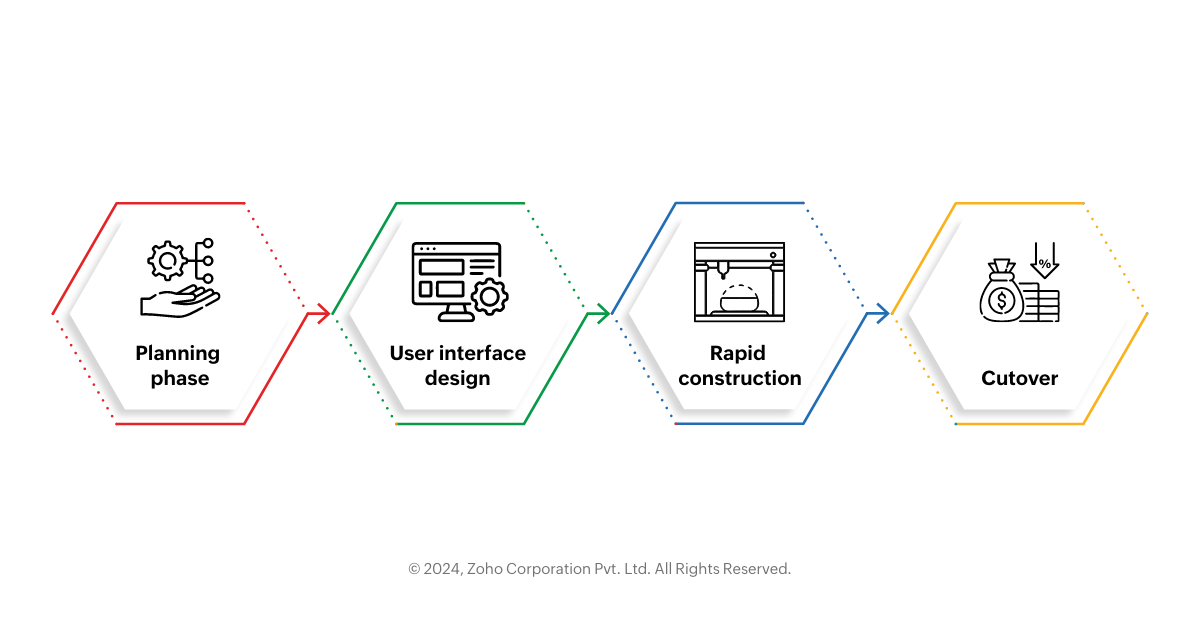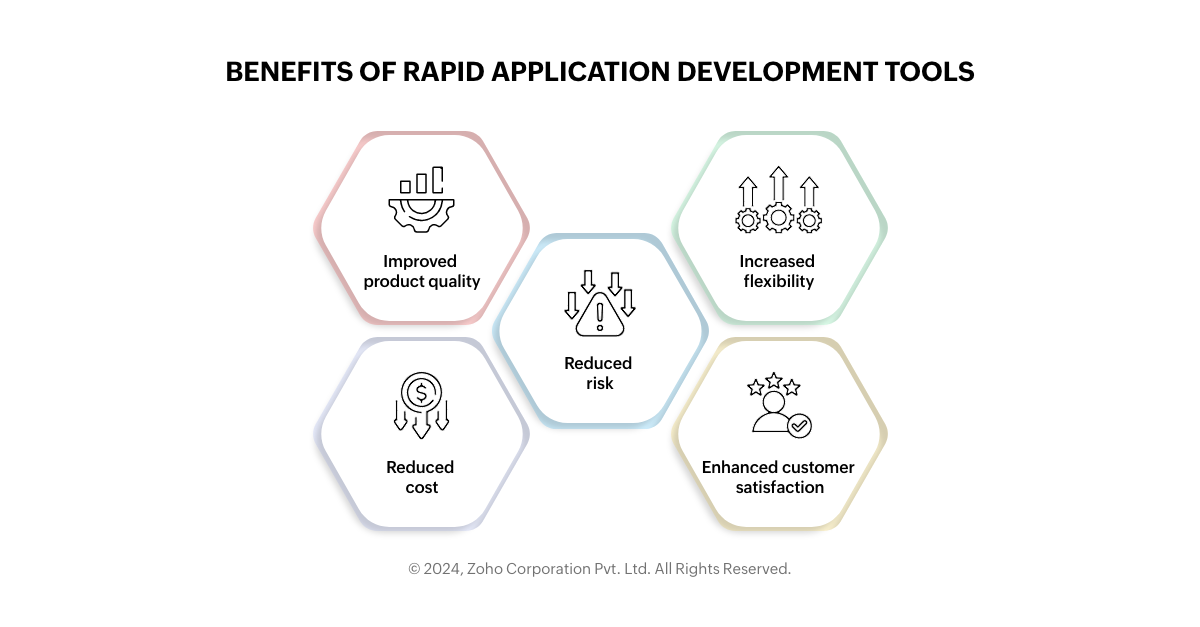- HOME
- Know Your Tech
- Demystifying rapid application development: A comprehensive overview and how it can accelerate app development
Demystifying rapid application development: A comprehensive overview and how it can accelerate app development
- Last Updated : August 15, 2024
- 458 Views
- 6 Min Read
Innovation isn't just a buzzword; it's a necessity for businesses striving to maintain their competitive edge, even more so in the software development landscape. Enter rapid application development (RAD) frameworks—a refreshing approach to app development that promises to revolutionize the way we create software. In this article, we'll dive into the world of RAD, exploring its principles, methodology, and how it works to boost app development efficiency.
Understanding RAD frameworks
Originating in the 1990s as a response to the rigid waterfall model, RAD methodology prioritizes rapid prototyping, continuous feedback, and iterative development. Its fundamental principle is to accelerate the delivery of high-quality software by embracing flexibility and collaboration. James Martin, a visionary in the field of software development, played a significant role in popularizing the RAD framework with his influential writings and lectures advocating for dynamic and iterative approaches. Unlike traditional methodologies, the RAD framework thrives on adaptability, enabling developers to respond swiftly to evolving requirements and user feedback. Martin's contributions not only shaped RAD methodology but also inspired a generation of developers to rethink their approach to software engineering.
How RAD works

Rapid application development (RAD) methodology streamlines software development into four distinct phases, incorporating efficient project management strategies and addressing key risk factors:
Planning
In this foundational stage, stakeholders and software developers collaborate to define project goals, scope, and requirements. The planning phase serves as the roadmap for the entire software development process, ensuring alignment with business objectives and user needs.
User interface design
RAD emphasizes user-centric design by engaging software developers in creating prototypes that simulate the end product's interface and functionality.
Through iterative feedback loops, developers refine designs to optimize user experience, mitigating key risk factors, such as usability issues and ensuring the software meets user expectations.
Rapid construction
Software developers then dive into the construction phase, leveraging the RAD approach to swiftly build and iterate upon the software.
By breaking down development tasks into manageable chunks, RAD minimizes development bottlenecks and accelerates time to market, reducing the key risk factors associated with prolonged development cycles.
Cutover
The culmination of RAD is the cutover phase, where the software is deployed to the live environment.
Software developers work closely with stakeholders to manage the transition smoothly, addressing key risk factors, such as data migration challenges, and ensuring minimal disruption to operations.
RAD's emphasis on collaboration, iterative development, and rapid prototyping enables software developers to navigate the complexities inherent in software development while delivering innovative solutions that align with business objectives and exceed user expectations.
Benefits of rapid application development tools

Improved product quality
RAD's commitment to continuous feedback and testing serves as a crucible for refining the product to meet and exceed user expectations. By fostering an environment where feedback is not only encouraged but actively sought at every stage of development, RAD ensures that each iteration of the product is honed to perfection.
Reduced risk
RAD's approach to development mitigates risks by dissecting the project into smaller, more manageable components. By doing so, RAD reduces the likelihood of catastrophic failures associated with traditional monolithic development approaches. Moreover, the iterative nature of RAD allows teams to identify and address potential issues early on, minimizing the impact of unforeseen challenges. This proactive risk management strategy instills confidence in stakeholders and ensures a smoother journey from conception to delivery.
Increased flexibility
Unlike traditional development methods, RAD doesn't resist change but adapts to it seamlessly. This means that software development teams can easily accommodate new requirements or user feedback without major disruptions to their workflow. This flexibility enables teams to make quick adjustments, experiment with different approaches, and deliver solutions faster. It also allows them to respond promptly to market changes or emerging opportunities, staying agile and competitive in evolving environments.
Reduced cost
RAD's emphasis on early feedback and testing is cost-saving boon for businesses. By identifying and addressing issues early in the development process, RAD minimizes the need for costly reworks and last-minute fixes. Moreover, the iterative delivery model employed by RAD ensures that resources are allocated judiciously, maximizing ROI and minimizing wastage. This cost-conscious adaptive software development model enables businesses to deliver high-quality products within budgetary constraints, driving sustainable growth and profitability.
Enhanced customer satisfaction
RAD methodology puts customer satisfaction first by involving users from start to finish. By working together, RAD not only ensures the final product is user-friendly but also makes customers feel valued as there is clear communication throughout the development journey.
Tips for successfully implementing a RAD framework
Choose the right team
The success of RAD hinges on assembling a dynamic and cohesive team equipped with a diverse array of skills and expertise. From project managers to meticulous testers, each team member plays a crucial role in realizing the project's vision. Through open communication and collaboration, RAD teams can harness the collective intelligence and creativity of its members, propelling the project to new heights.
Prioritize user involvement
User feedback is the lifeblood of RAD, driving continuous improvement and innovation. To unlock the full potential of the RAD approach, teams must prioritize user involvement at every stage of the development process. Whether through user interviews, usability testing, or feedback sessions, soliciting input from end-users ensures that the final product aligns closely with their needs and preferences. This user-centric approach to project management not only fosters a deeper understanding of user requirements but also instills a sense of ownership and pride among stakeholders.
Focus on time-boxed delivery
Time-boxed delivery is a core tenet of RAD, ensuring that projects remain on track and progress is steadily made towards the desired outcome. By breaking down the development process into manageable iterations, RAD teams can deliver value incrementally, keeping stakeholders engaged and informed throughout the journey. This iterative process reduces the risk of project delays and enables teams to respond quickly to changing priorities and emerging opportunities.
Ensure quality control
The most importance is given to quality control in the RAD framework, ensuring that each iteration of the product meets the highest standards of excellence. From rigorous prototyping to exhaustive testing, RAD teams leave no stone unturned in their quest for perfection. By fostering a culture of accountability and excellence, RAD teams can deliver products that not only meet but exceed user expectations, driving customer satisfaction and loyalty.
By implementing these tips and understanding the benefits and real-world examples of RAD, businesses can successfully adopt this approach to accelerate their app development and stay competitive.
Real-world examples of RAD success stories
RAD has proven effective across diverse industries and projects, spanning from web applications and enterprise software to mobile apps. It's like a Swiss Army knife—versatile and adaptable to different tasks.
Now let's explore some real-life examples to see how RAD gets the job done.
Facebook is a prime example of a successful RAD implementation. The company uses a rapid development cycle, with frequent updates and user feedback to improve the platform
Lyft
Popular transport company Lyft adopted agile methods early on to evolve rapidly, based on user input. Though the exact approach isn't specified publicly, their quick adaptations to user needs are widely recognized.
By embracing the RAD model, WhatsApp quickly developed a messaging platform that resonated with millions of users worldwide. This iterative approach allowed WhatsApp to continuously enhance its features and user experience, fueling its rapid expansion.
What's the verdict?
Rapid application development (RAD) tools help navigate the complex terrain of software development by offering innovation and efficiency. With RAD tools, developers can build apps quickly and flexibly, delivering solutions that truly make an impact. If you're on the lookout for a RAD platform, consider checking out Zoho Creator. It's a user-friendly low-code platform packed with features to streamline your development process. With Zoho Creator, you can create tailored solutions that meet your exact needs, ensuring you're equipped to tackle the challenges of modern software development head on.
Click below to delve into the world of rapid application development.
 Stephen
StephenStephen is a product marketer at Zoho Creator. An avid writer, he plies his trade evangelizing low-code during the day and pens songs at night. Sneakerhead and sushi enthusiast too.



